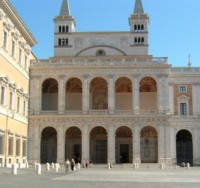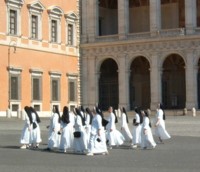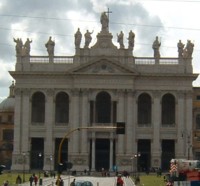The Basilica of San Giovanni in Laterano (St. John Lateran) is Rome’s cathedral, a church originally established by Constantine, the first Christian emperor of Rome.
San Giovanni in Laterano, or St. John Lateran, is a church with an impressive past. The ‘Lateran’ part of its name is taken from a Roman family who owned property on this hill, before it was confiscated by Nero. After his conversion to Christianity, Constantine founded a church here in what had been his Lateran Palace.
The principal, eastern, facade dates back to 1736 and is dominated by gigantic stone saints, gleaming white. This is one of the principal landmarks of the city, and can be seen from as far away as the Vittoriano monument, and also from the air (aeroplanes taking off from Ciampino frequently fly directly overhead). The more charming northern facade is older and was designed by Domenico Fontana in 1586.

The view of the facade is a well-known one: it features in the opening sequence of the film Roman Holiday, and is also the backdrop to Italy’s biggest concert, a free event every Primo Maggio (1st May).
The interior of the basilica, having endured countless changes over the centuries, is decorated in a rather heavy and unappealing style. The altar is supposed to contain the heads of St. Peter and St. Paul – if so, they have endured many vicissitudes, such as sackings and earthquakes.
The Cloister of the basilica is open to the public, and there is a charge for admission. It boasts spiral columns and Cosmatesque mosaics.
The Baptistry, just outside the church is supposed to be the earliest of its kind, and was converted from an earlier Roman temple.

San Giovanni is close to the Metro station of the same name. You can walk there from the Colosseum, along Via San Giovanni in Laterano, or take a bus (numbers 85, 87, 850, 117). The baptistry is closed at lunchtime.
In the immediate vicinity you can see the religious shrine of the Holy Stairs, and the well-preserved Roman Aurelian Wall with the original fortified gateway alongside the present day Porta San Giovanni.
On this site
Useful external links
